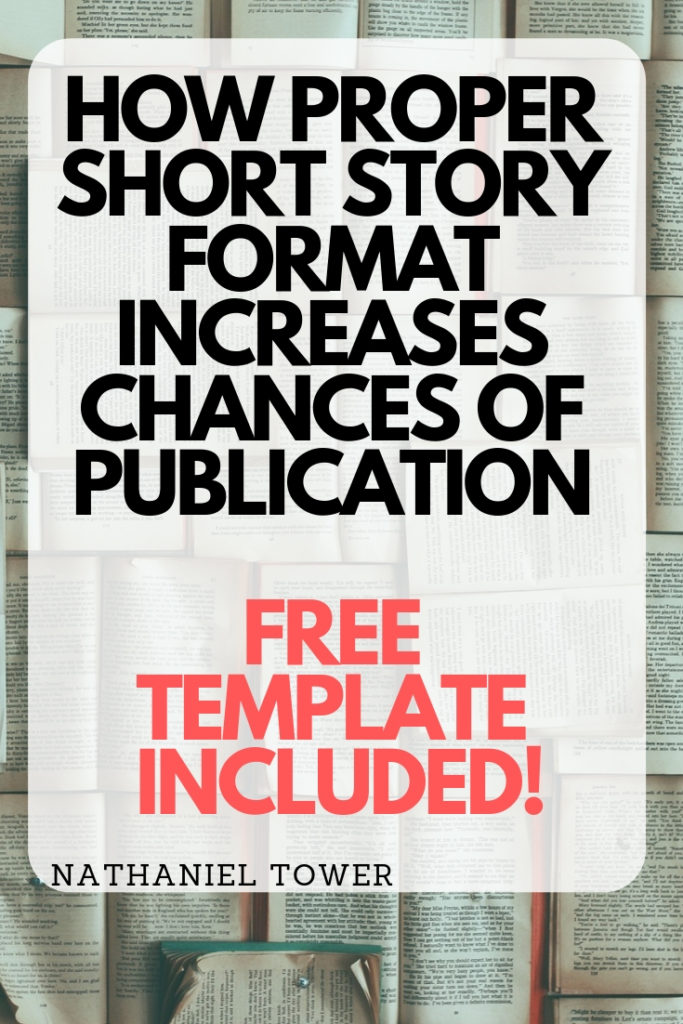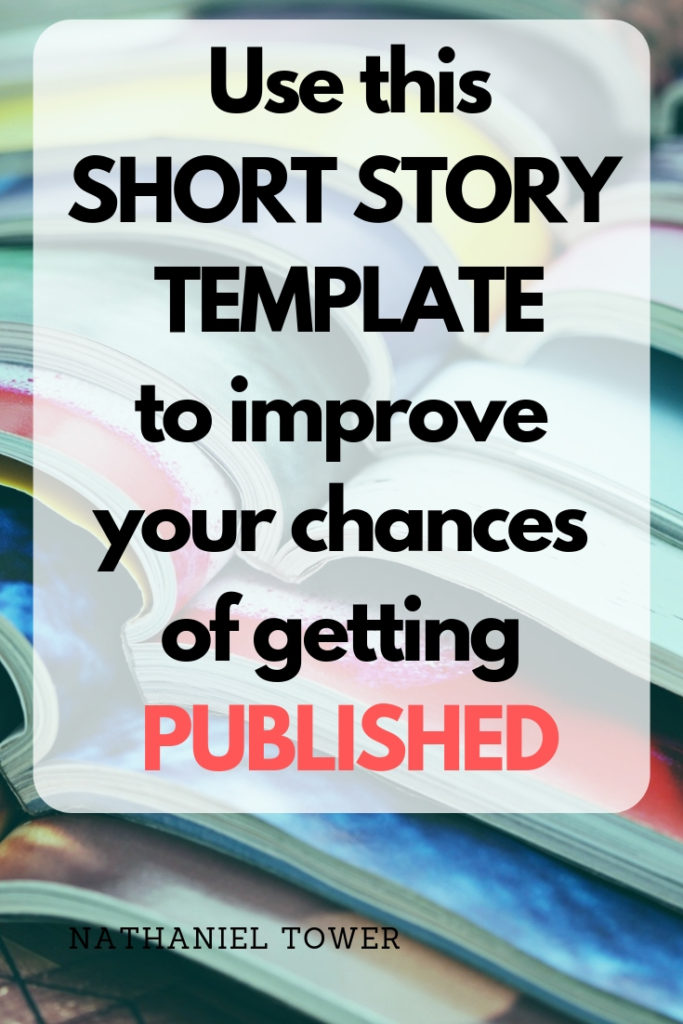Last Updated on July 7, 2024 by Nathaniel Tower
Knowing how to format your short story is the first step to getting published. No matter how great your story is, it doesn’t stand a chance if you don’t format it in a way that’s easy to read and clearly tells a publisher you know what you’re doing.
Download your free short story template
Want to skip this article and just download your template so you can start writing your next short story? Go right ahead! You can download your free short story template right here.
For anyone who wants to read about why you should use proper short story format, continue below.
Always use professional short story format
The quickest way to get your short story rejected is by ignoring submission guidelines. If you don’t follow a publication’s formatting requirements, they aren’t going to publish your story because they’re never even going to read it. If you want to be published, you have to play the game according to their rules. The big problem though is that most literary magazines don’t clearly outline all the rules. When they don’t, that’s when you need to use a professional short story manuscript format.
Whether you’re submitting to World’s Worst Stories or to Only the Best Authors Get Published in Our Pretentious Zine, you need to present your story in a format that’s easy to read and shows you’re a serious author. The standard short story format accomplishes both of these things. When the slush editor opens your file, they’ll immediately want to read your story because it’s so inviting. If you send something that’s not properly formatted, they’ll likely let out a long sigh and throw it into the rejection pile without reading your outstanding first sentence.
At my own literary magazine, Bartleby Snopes, we automatically rejected anything that wasn’t double spaced. That was our only formatting request. Even though we clearly laid this out, at least 10% of submissions were sent single spaced. While we didn’t require a standard manuscript format, stories that were professionally formatted were much more likely to be published. Why? First of all, they made a good impression. Second, good writers are more likely to use the proper format. It may not seem like a big deal, but it is a differentiator when you’re up against thousands of other submissions.
The key elements of short story manuscript format
The great thing about a proper short story manuscript is how easy it is. Here are the general rules (see below for a free template you can download and use over and over again for your own stories and submissions):
- 1-inch margins all around (.5-inch for page headers)
- 12-point font
- Courier, Times New Roman, Arial, or something similar and easy to read (don’t get creative with your font choice)
- Indent paragraphs using a standard tab
- Double space the entire story
- Don’t add an extra space after paragraphs
- Use only one space after periods and other end punctuation marks
- Include your complete contact information single-spaced in the top left corner of the first page (name, address, phone number, and email address)
- Center the title and your byline approximately halfway down the first page
- On the first page, include an approximate word count in the top right corner
- On all subsequent pages, include the title, your last name, and the page number in the top right corner as a page header
- Use italics for things that should be italicized (old-school formatting tells you to underline things that should be italicized, but this is an archaic practice because we use computers now, not typewriters)
- Use quotation marks for dialogue and start a new paragraph when a new person is talking (how to write better dialogue)
- There’s no need to put “The End” at the end of your story but it’s unlikely you’ll get rejected just because you do
That’s pretty much all there is to it. If it sounds too complicated, then I’ve created a handy short story manuscript format template you can download and use for free. Download it in whatever file format you need (.docx, .rtf, .odt, etc.) by going to File > Download as. Distribute however you’d like. No strings attached.
Use a short story template every time you write a story
Every time you write a story, you should use your proper manuscript format. While it might be tempting to open up a Word doc and just start typing away, you’ll save a lot of time in the long run if you use proper formatting upfront. It’s super easy to do. Just create a template and use it every time you start writing a new story.

Never submit a short story that isn’t properly formatted
Any decent literary magazine gets hundreds or thousands more submissions than they can publish in a given month. The easiest way for them to save time and narrow the candidate pool is by rejecting anything that doesn’t follow the submission guidelines. Don’t be the writer who gets rejected immediately because you were too lazy to format your story correctly.
If you submit a properly formatted short story, not only do you have a better chance of getting published, but you also have a better chance of making money as a writer.
Short story template Word
It doesn’t matter what tool you use to create your short story. Most writers seem to prefer Google Docs or Microsoft Word, but there are many other programs you can use. If you want a short story template in Word or another compatible program, then you can get one free using the download link below.
Download your free short story manuscript template here and never be rejected again*
*This is not an actual guarantee that you won’t be rejected. You will still be rejected. It’s just a bold call to action to make you go ahead and download the template because I care about your success.
Always follow their formatting rules first
As we’ve established above, you should always use a professional short story format when you submit your work. However, it’s also important to respect an individual publication’s formatting requirements. Reading the guidelines thoroughly before you submit is always a requirement. While most publications aren’t particular about formatting, some have very specific requests. I’ve seen things like 10.5-pt font, single space with an extra space between paragraphs, 1.5 spacing, no indents, 5-space indents, etc. If any of these requirements are laid out, you’ll need to abandon your proper short story manuscript format and go with what they want. For everyone else–including the publications that say they don’t care about formatting–make sure you use the standard format outlined in this post.
Do you have any tips for short story formatting? Share your suggestions in the comments.
Short Story Format FAQs
How should you format a short story?
If you are planning to submit your short story for publication, you should use the commonly accepted standard manuscript format. This format is very easy to follow, especially if you start from a template.
What is short story manuscript format?
Short story manuscript format is a widely accepted format that you should almost always use when submitting your short stories. The format is easy to follow and makes your story look professional. Key components include double spacing, 12-point font, indenting your paragraphs, 1-inch margins, page numbers and headers, and placing your contact information at the top.
Can I download a short story template?
Using a template to format your short story is a great idea. You can download a free short story template on the Nathaniel Tower Juggling Writer website.
Should you always use standard manuscript format for my short stories?
Generally speaking, you should use standard manuscript format if you want to get your short story published. The only exceptions to this rule would be if the publication requires a different format or if your story is an experimental piece that requires a different format in order to be read correctly. In the latter case, you can use most of the principles of standard manuscript format.
Are short stories double spaced?
Yes, you should almost always double space your short story if you plan to submit it for publication. This is part of standard manuscript format. In some rare cases, a publication may request for your story to be single spaced. Make sure you follow their guidelines if you plan to submit.
Do you indent a story?
Every new paragraph in your story should be indented. Use a standard tab rather than hard spacing to indent your paragraphs.
What font should you use for a short story?
Use a 12-point font that’s easy to read, such as Courier, Times New Roman, or Arial. You may be tempted to use a unique font to stand out, but this will make you look unprofessional.
What is a story format?
A story format could refer to the physical formatting you use to create your manuscript, or it could refer to the type of story you are writing (short story, novella, novel, etc.).




I have been told that courier is no longer the proper font for short story submissions. Any comment on this?
Kate, thank you for reading and commenting. Courier is still acceptable but not the preferred font by any means. It can feel a bit archaic since it’s traditionally a typewriter font. I recommend Arial or Times New Roman.
Thanks for the information.
Great information, thank you. I agree about proper formatting. In busy publications, submissions are not even read if not properly formatted. Thomas Falater, New Bruinswick, Maine
Thank you for clearly laying out the short story formatting, Nathaniel. As a new writer I searched online for some time to find what was expected when the submission guidelines I had weren’t specific. What I found was a whole lot of conflicting information. I’ll be saving this for future reference.
I imagine the short story formatting should also be used when submitting essays, is that correct?
Thanks Nathaniel!
Hi Jules! I’m glad you found this helpful. I don’t have much experience submitting essays, but I would imagine this format would work quite well. Good luck with your submissions!
How many spaces between the title and start of text?
I recommend using four spaces (or two double spaces) between the title and the start of text.